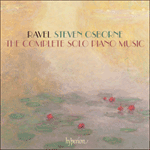
Welcome to Hyperion Records, a British classical label devoted to presenting high-quality recordings of music of all styles and from all periods from the twelfth century to the twenty-first.
Hyperion offers both CDs, and downloads in a number of formats. The site is also available in several languages.
Please use the dropdown buttons to set your preferred options, or use the checkbox to accept the defaults.

| Steven Osborne (piano)» More |
The first public performance of the Menuet was given on 18 April 1898 by a pianist and friend who was to prove an invaluable champion of Ravel’s music for most of the next decade. Ricardo Viñes, a Spaniard who had become a friend of Ravel at the Conservatoire, was a brilliant pianist with an exceptional range of keyboard colours (according to one acquaintance, ‘an express bar of delights’).
from notes by Roger Nichols © 2011
La première exécution publique du Menuet a été donnée le 18 avril 1898 par un pianiste et ami qui allait s’avérer être un champion inestimable de la musique de Ravel pendant la majeure partie de la décennie suivante. Ricardo Viñes, un Espagnol qui s’était lié d’amitié avec Ravel au Conservatoire, était un pianiste brillant doté d’un éventail exceptionnel de couleurs pianistiques (selon un ami, «un express-bar de délices»).
extrait des notes rédigées par Roger Nichols © 2011
Français: Marie-Stella Pâris
Die erste öffentliche Aufführung des Menuet wurde am 18. April 1898 von einem Pianisten und Freund gegeben, der sich in der folgenden Dekade als unschätzbarer Verfechter der Musik Ravels entpuppen sollte. Der Spanier Ricardo Viñes, der sich am Conservatoire mit Ravel angefreundet hatte, war ein brillanter Pianist, der über eine außergewöhnliche Palette an Klangfarben verfügte („eine Express-Bar der Köstlichkeiten“, wie ein Bekannter es ausdrückte).
aus dem Begleittext von Roger Nichols © 2011
Deutsch: Viola Scheffel
 Ravel: The Complete Solo Piano Music Ravel: The Complete Solo Piano MusicNew releases of Steven Osborne’s best-selling discs have become some of the most eagerly awaited events in the pianophile diary. This most delicate and subtle of musicians also displays a pyrotechnical deployment of digital acrobatics, mesmerizing ...» More |

